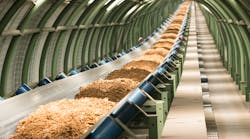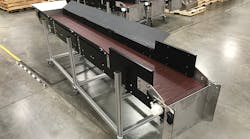Material handling conveyors are often a key element of automated manufacturing systems. They safely and efficiently transfer parts across the warehouse floor from station to station or even through other automated systems.
Automated conveyors are ideal for whenever a business wants to eliminate the human element from transporting parts. Determining what kind of material handling conveyor is best suited for your operations requires a detailed look at the part, the needs of the manufacturing process, and the layout of the process.
Types of Conveyors
There are many types of conveyors an automation equipment manufacturer will recommend depending on the aforementioned criteria. Some of the more common conveyor systems include:
- Belt conveyors: Ideal for simple transportation of parts or materials without the need for part orientation, belt conveyors consist of two or more pulleys and an endless loop of the conveyor belt rotated around them.
- Overhead conveyors: This conveyor system utilizes a chain that runs through a track mounted overhead. Parts are hooked to the chain and hang down below. It is ideal for automated paint systems since the part has the most exposed surface area when being transported with an overhead conveyor.
- Pallet conveyors: With a pallet conveyor, a pallet rides on top of a chainset with rollers. The pallet is in a fixed position during transportation, enabling automated unloading during the process.
- Precision index conveyors: Fixtures maintain part orientation during transportation on a precision index conveyor. This system enables high-speed movement of the part throughout the manufacturing process while ensuring part orientation for other automated systems.
The Part's Impact
The part plays a key factor in what type of conveyor is needed. A simple belt conveyor is sufficient if there is no need for part orientation. Should the part merely need to be transferred from point A to point B, belt conveyors are a quick and easy way to accomplish this task.
The make-up of the part can determine what materials are needed for the belt or other conveyor systems. If the part's surface is a critical component, a change in the hardness of the belt material may be needed to keep the integrity of the part intact.
For example, windshields are transported on strand conveyors. Each strand is a 1-inch wide linked rubber belt that allows a piece of glass to sit flat between two strands. The material, along with the way it holds the windshield, saves the glass from getting marred.
The food industry requires conveyors to be made from materials that pass the health code in addition to specifications on how it gets cleaned. Food grade materials that maintain the structural and hygienic integrity of the products are a necessity for this industry.
Automated paint systems use overhead conveyors to transport parts through the sprayers and drying ovens. By using an overhead conveyor, the maximum amount of surface area of the part can be exposed to the sprayers since it's not laying down on a surface.
The Process' Impact
The most prominent factor in determining the type of conveyor needed to handle materials is the manufacturing process. Within the processes, a key consideration is part orientation. If the part has a process done in two different machines but can't change orientation, the automated system needs a conveyor with the capabilities to match.
If a change in part orientation is critical to the process, the material handling conveyor needs additional equipment to track and locate the part. Often, a precision index conveyor is an ideal option. The precision index conveyor manages part orientation during transportation so other equipment can easily find and manipulate the part per the process parameters.
Another material handling option is a pallet conveyor. Similar to precision index conveyors, pallet conveyors have fixtures for the part to maintain orientation through transportation. The pallet rides on top of a chain set with rollers. When the pallet reaches the portion in which the next event in the manufacturing process happens, another element comes into contact and locates the part.
Additionally, automated or human part loading determines a need for location equipment or robots. If the process requires parts to be loaded on to or unloaded from a conveyor with automated systems, the conveyor will need a vision system to find and identify the part on the conveyor and transmit data to a robot to physically manipulate the part.
The Layout's Impact
The layout of the conveyor can determine which style of conveyor is needed and the materials used. Conveyors may need to travel on an incline, a decline or around corners as part of the process. If using a belt conveyor and the layout requires an incline or decline during the transportation, the belt material will have to be abrasive enough to keep the part in place.
Conveyors that turn corners need a corner section utilizing a different material to ensure the part follows the intended path.
The layout can affect more than the conveyor materials such as the speed at which the conveyor operates and the location of ancillary equipment used to locate and manipulate the part during transport.
The part, the manufacturing processes and the layout have a prominent impact on what material handling conveyor to use. Examining these three factors will yield the conveyor options that match your needs, along potential ancillary automated equipment.















